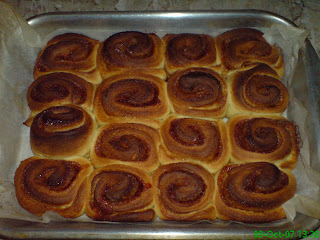 I generally don’t eat oysters, well at least the Pinoy way. People here give them a brief hot water bath then make them swim in a pool of vinegar and chopped onions. To be honest, I have never even tried it. The thought of eating slimy green blobs swimming in vinegar and raw onions is just nauseating. I hate vinegar (but not in pinaksiw, or when vinegar is cooked).
I generally don’t eat oysters, well at least the Pinoy way. People here give them a brief hot water bath then make them swim in a pool of vinegar and chopped onions. To be honest, I have never even tried it. The thought of eating slimy green blobs swimming in vinegar and raw onions is just nauseating. I hate vinegar (but not in pinaksiw, or when vinegar is cooked).I first tasted oysters in Bangkok. In Thailand, almost everything is served swimming in chili and I thought it was an appropriate time to be adventurous. We were at a Thai-Chinese seafood restaurant and were served a plateful of oyster omelet on a sizzling platter. It was buried in a mound of julienned leeks and served with some chili paste. I actually enjoyed it, and could not believe myself. The chili and onions (!) helped initially, but I soon realized the egg actually stole away the show from the oysters. And the little blobs weren’t slimy at all. It became one of my favorite Thai/ Chinese dishes.
So, confronted with a mound of fresh oysters, I decided to make some omelet:
You can buy oysters on the shell or get the ones from the market shelled. Whatever the case may be, you need them shelled, cleaned, rinsed and briefly doused with hot water. You will need 1 cup of oyster meat. Strain then set aside.
If the oysters are “leaking out” some juice, add this to three eggs and beat until combined. Otherwise, substitute three to four tablespoons chicken stock. Season with some pepper and salt.
On a VERY HOT oiled pan, preferably non-stick, add a tablespoon of chopped garlic and two slices of ginger that have been slivered. You may adjust the proportion, but this dish is usually garlicky. Dump in the oysters (DO NOT include any water dripping from the oysters) and toss briefly. The pan has to be H-O-T so as not to make the oysters sweat, otherwise this will turn into a stew. Toss for around 20 to 30 seconds.
Lower heat to med-high, then pour in the eggs. Let the bottom part set before mixing. We are not making a pancake or the western omelet. This is more like scrambled eggs. It is difficult to give an amount of time, but you have to inspect the eggs for the doneness that you prefer.
Serve garnished with julienned spring onions, coriander leaves and chili sauce.

















